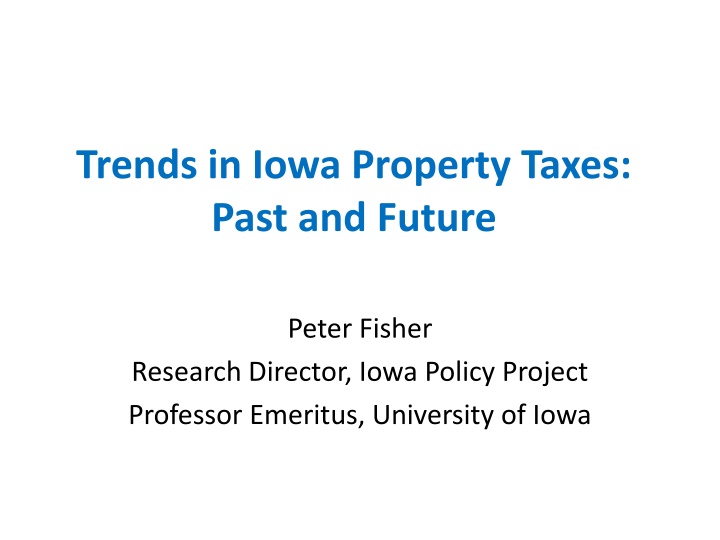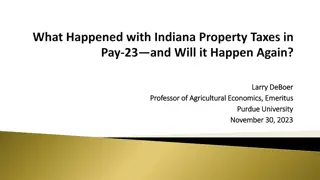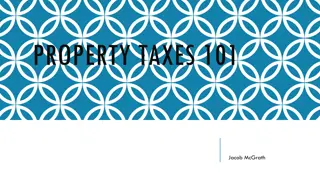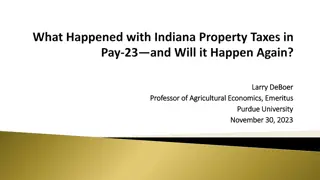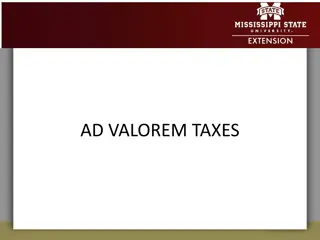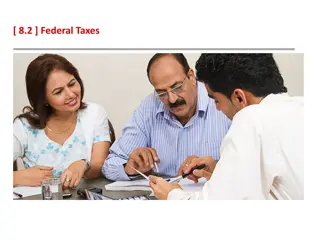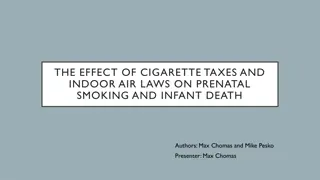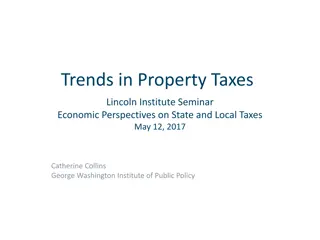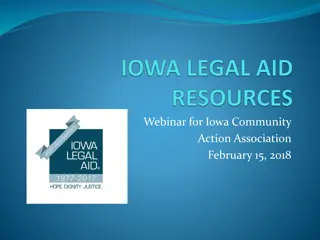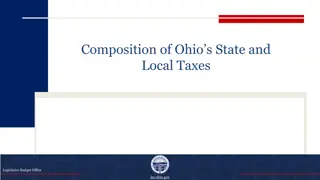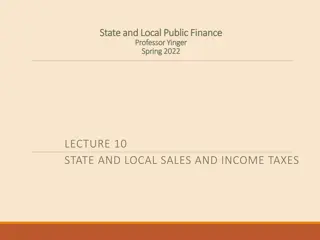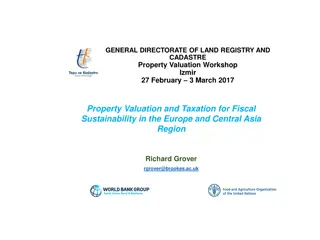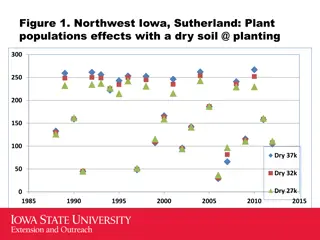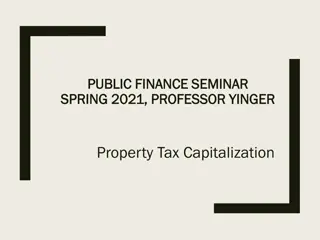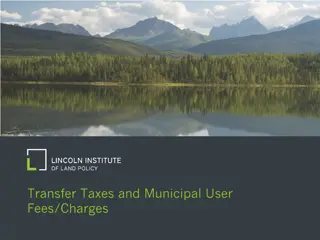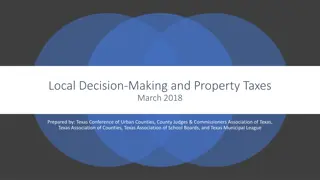Trends in Iowa Property Taxes: Past and Future
Property taxes in Iowa have decreased as a source of local revenue over the years. The decline is more significant when looking at own-source revenue excluding state and federal grants. Other revenue sources like charges and sales taxes have become more important. Different trends are observed for counties and cities in terms of reliance on property taxes compared to other sources of revenue.
Download Presentation

Please find below an Image/Link to download the presentation.
The content on the website is provided AS IS for your information and personal use only. It may not be sold, licensed, or shared on other websites without obtaining consent from the author.If you encounter any issues during the download, it is possible that the publisher has removed the file from their server.
You are allowed to download the files provided on this website for personal or commercial use, subject to the condition that they are used lawfully. All files are the property of their respective owners.
The content on the website is provided AS IS for your information and personal use only. It may not be sold, licensed, or shared on other websites without obtaining consent from the author.
E N D
Presentation Transcript
Trends in Iowa Property Taxes: Past and Future Peter Fisher Research Director, Iowa Policy Project Professor Emeritus, University of Iowa
Property taxes have become a less important source of local revenue in Iowa and in the U.S. 40% 34.2% 35% Iowa 28.8% 30% 30.7% 25% 27.0% U.S. 20% 15% Percent of total revenue of all local governments, 1977-2016 10% 5% 0% 1977 1978 1979 1980 1981 1982 1983 1984 1985 1986 1987 1988 1989 1990 1991 1992 1993 1994 1995 1996 1997 1998 1999 2000 2002 2004 2005 2006 2007 2008 2009 2010 2011 2012 2013 2014 2015 2016
Property taxes have declined even more as a share of own-source revenue 70.0% 57.8% 60.0% Iowa 50.0% 44.4% 50.4% 40.0% U.S. 40.2% 30.0% Percent of own-source local government revenue, 1977-2016 (state and federal grants excluded) 20.0% 10.0% 0.0% 1977 1978 1979 1980 1981 1982 1983 1984 1985 1986 1987 1988 1989 1990 1991 1992 1993 1994 1995 1996 1997 1998 1999 2000 2002 2004 2005 2006 2007 2008 2009 2010 2011 2012 2013 2014 2015 2016
Property taxes and grants have become less important, while charges and sales taxes have grown 100% Percent of Total Revenue of all Local Governments in Iowa 90% 32.9% 32.2% 34.7% 80% 70% 60% State grants 50% 29.8% 28.8% 34.4% Property taxes 40% Fees, Fines and Charges 30% Other taxes & miscell 17.3% 17.5% 14.1% 20% Sales Taxes 6.3% 10% 5.0% 7.4% Federal grants 3.4% 6.4% 3.5% 3.0% 0% 1977 1997 2016
For counties, property taxes have become more important 100% Percent of total revenue of County Governments in Iowa 90% 80% 43.3% 44.3% 46.6% 70% 60% Property taxes 50% State Grants 30.1% 40% 34.3% 35.4% Other taxes & miscell 30% Charges & utility revenue 12.3% 20% 7.6% Sales taxes 6.5% 6.1% 9.5% 10% 5.2% Federal grants 4.9% 7.7% 0% 1977 1997 2012
County revenues, FY2017 100% 90% Property Taxes 80% 49.9% Intergovernmental 70% 60% Other taxes 50% 40% Licenses, permits & charges Other 32.7% 30% 20% 7.8% 10% 5.8% 3.9% 0%
City share of property taxes rose, school share declined, county share stable, 1977-2012 100% 80% 46.1% 56.8% 60% School City County 40% 29.8% 20.0% 20% 24.1% 23.3% 0% 1977 1982 1987 1992 1997 2002 2007 2012
Local government funding in Iowa has been pretty stable: It has fluctuated around 7.5% of personal income for the past 40 years 9.0% 8.5% U.S. 8.0% 7.5% Iowa 7.0% 6.5% Own source revenue of local governments as a percent of state personal income, 1977-2016 6.0% 5.5% 5.0% 1977 1978 1979 1980 1981 1982 1983 1984 1985 1986 1987 1988 1989 1990 1991 1992 1993 1994 1995 1996 1997 1998 1999 2000 2002 2004 2005 2006 2007 2008 2009 2010 2011 2012 2013 2014 2015 2016
Future Trends in Local Finance in Iowa What is likely to happen with non-property tax revenues? Intergovernmental grants Fees, fines, and charges Local option taxes What constraints will we see on property tax growth?
Intergovernmental Revenue Will the emphasis on tax cutting at the state and federal levels continue? If so . Federal aid likely to continue to fall in real terms, but already only 1.5% of total county revenue State aid likely to fall in real terms? RUTF tax is per gallon, not tied to price increases Gas tax was stuck at 20-21 cents per gallon1989-2015; over that period state grants to local governments in Iowa remained at about 31% of all revenue Property tax backfill likely to end; currently equal to about 2.7% of county property taxes levied
Fees, Fines, and Charges Experience in California replicated here When property taxes limited, local governments seek out ways to charge for services Charges have grown substantially for Iowa cities, but not for counties Currently not much help to counties about 5% of revenue Constraints in Iowa Can t collect more than needed to finance the service in question Is there much room for growth? What can counties do beyond park fees?
Local Option Taxes Sales Taxes Only 5% of county revenue Only 4 counties (Polk, Johnson, Clark and Osceola) do not have LOST; all others levy the maximum 1% But will the sales tax base grow more slowly than the property tax base? Will the 2018 tax bill stem the loss on internet sales? Hotel-Motel Tax 19 counties impose this tax, most at 7% Limited base in unincorporated areas
The Property Tax Base Growth in residential and ag actual value ? Rollbacks on residential and ag property 55%-57% for past 5 years Growth in commercial and industrial property ? Continued decline in multi-residential rollback, from 71.25% for 2019 to residential fraction for 2022 But only 2.3% of the tax base statewide Over the past 14 years the state average county general fund levy rate has been remarkably constant, at around $6.50, while the base has grown 3-4% per year.
Property Tax: Other Issues Continued expansion of TIF by cities Levy rate limits remain while the growth cap adds a new constraint Incentives to increase borrowing Debt service has no rate limit and is outside the growth cap Debt service is exempt from TIF
County revenue growth statewide has exceeded 2% every year since 2002
Over time a 2% growth cap could force a growing county to drastically cut the tax rate to reduce revenue $18,000,000 $16,000,000 $14,000,000 $12,000,000 $10,000,000 By the tenth year, rate would have to fall 25% Revenue grows with tax base at 5% $8,000,000 $6,000,000 Revenue limited to 2% growth $4,000,000 $2,000,000 $- 2020 2021 2022 2023 2024 2025 2026 2027 2028 2029 2030
Where the Growth Cap Could be a Problem Supermajority: How many counties have a 5-person board? 38 In how many of those did property tax revenues grow by more than 2% per year on average from 2010 to 2017? 34 In how many did property taxes growth more than 2% in at least 4 of the past 7 years? 32 In how many of those did property tax revenues grow by more than 2% at least twice in the past 7 years? 38
Five-supervisor counties with average growth in property tax revenue > 2% (2010-2017) GUTHRIE 7.6% WINNESHIEK 4.3% CASS ADAIR OSCEOLA POCAHONTAS LYON CEDAR 7.1% 7.1% 6.7% 6.3% 6.1% 5.2% 5.2% 5.2% 5.1% 4.8% 4.8% 4.8% 4.6% 4.4% 4.4% 4.3% JOHNSON WASHINGTON CRAWFORD CLAY SCOTT POLK WOODBURY MUSCATINE ADAMS EMMET PALO ALTO WEBSTER HUMBOLDT BUENA VISTA BLACK HAWK LEE 4.2% 4.1% 3.9% 3.8% 3.6% 3.6% 3.4% 3.3% 3.3% 3.3% 3.2% 3.2% 3.1% 2.7% 2.5% 2.4% O BRIEN JONES POTTAWATTAMIE MONTGOMERY DICKINSON PLYMOUTH SIOUX IOWA CHEROKEE CHICKASAW
